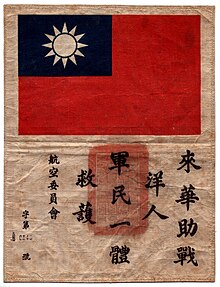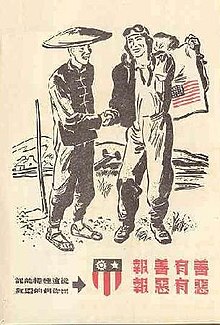A blood chit (Chinese: 血幅; pinyin: xuè fú) is a notice carried by military personnel and addressed to any civilians who may come across an armed-services member – such as a shot-down pilot – in difficulties. As well as identifying the force to which the bearer belongs as friendly, the notice displays a message requesting that the service member be rendered every assistance.[1]



The text (in Chinese, Korean, Japanese, and English) says:
I am an American (UNITED NATIONS) pilot. My plane has been shot down and I am helpless, but I want to get back and fight again for the peace of the world and your country.
If you will help me and yourselves by getting me to the nearest American unit, my Government will reward you. Help me and we will help you.
Etymology
editAlternative names are escape flag and identification flag (Chinese: 人物證明書; pinyin: rénwù zhèngmíng shū). "Chit" is a British English term for a small document, note or pass, representing a debt to be paid; it is an Anglo-Indian word dating from the late 18th century, derived from Hindi citthi.[2]
History
editThe first blood chit may have been made in 1793 when French balloonist Jean-Pierre Blanchard demonstrated his hot air balloon in the United States. Because he could not control the direction of the balloon, no one knew where he would land. Because Blanchard did not speak English, George Washington, according to legend, gave him a letter that said that all U.S. citizens were obliged to assist him to return to Philadelphia.[3]
In World War I, British Royal Flying Corps pilots in India and Mesopotamia carried a "goolie chit" printed in four local languages that promised a reward to anyone who would bring an unharmed British aviator back to British lines. The British officer John Masters recorded in his autobiography that Pathan women in the North-West Frontier Province (1901–1955) of British India (now modern day Pakistan) during the Anglo-Afghan Wars would behead and castrate non Muslim soldiers who were captured, like British and Sikhs.[4]
In the Second Sino-Japanese War prior to World War II, foreign volunteer pilots of Flying Tigers carried notices printed in Chinese that informed the locals that this foreign pilot was fighting for China and they were obliged to help them.[5] A text from one such blood chit translates as follows:
I am an American airman. My plane is destroyed. I cannot speak your language. I am an enemy of the Japanese. Please give me food and take me to the nearest Allied military post.
You will be rewarded.
On the UN chit from the Korean War, it is written in Japanese that cooperators will be rewarded and should help for his own 'benefit'.
United States Armed Forces
editWhen the U.S. officially entered World War II in December 1941, flight crew survival kits included blood chits printed in 50 different languages that sported an American flag and promised a reward for a safe return of a pilot.[6] The kit might also include gifts like gold coins, maps or sewing needles. Many U.S. flight crews that flew over Asia had their "blood chit" sewn to the back of their flight jackets. Some units added the blood chit to the crew's flight suits while other units gave the blood chit out only for specific flights. Currently, blood chits are a product of the Joint Personnel Recovery Agency. These recent government-issue items are a small sheet of Tyvek material [7] with an American flag and a statement in several languages indicating that the U.S. will reward anyone assisting the bearer to safety. They constitute a written promise of the US Government. Retired General Norman Schwarzkopf recounted that the CENTCOM Judge Advocate General during the Gulf War forward his approval for US pilots to carry such a chit.[8]
British Armed Forces
editExamples of blood chits issued to British RAF personnel in India in the 1940s are printed on thin sheets of silk cloth measuring 20 by 11½ inches (about 50 x 30 cm); they have the Union flag printed at the top left, and the following text in English and French alongside it:
Dear Friend,
I am an Allied fighter. I did not come here to do any harm to you who are my friends. I only want to do harm to the Japanese and chase them away from this country as quickly as possible.
If you will assist me, my Government will sufficiently reward you when the Japanese are driven away.
The main area of the document is printed in three columns with the same text in 15 Asian languages, including Malay, Burmese, Tamil, Thai and Bengali.
Such blood chits or goolie chits were issued to Royal Air Force pilots during the Gulf War. It identifies the bearer as friendly and is issued with gold sovereigns as an incentive.[9] Peter Ratcliffe recounted that it was issued to Special Air Service troopers prior to deployment. The gold sovereigns had to be returned unless troopers could prove they were legitimately used.[10] Peter de la Billière also recounted that all RAF aircrew were issued with "£800 in gold, to facilitate escape in case of trouble, and also a chit written in Arabic which promised that Her Majesty’s Government would pay the sum of £5000 to anyone who returned an airman intact to the Allies."[11] Former Special Air Service Sergeant Chris Ryan also received the same type of chit and gave it to a Syrian driver during his escape from Iraq.[12]
Americans during the Cold War
editDuring the Cold War, Americans flying reconnaissance over Eastern Bloc countries would be given blood chits in those various languages (e.g. Polish, Czech, and Hungarian) The chits read:
I am an American. I do not speak your language. I need food, shelter and assistance. I will not harm you; I have no malice toward your people. If you help me, my government will reward you.
Norwegian Armed Forces
editNorwegian commandos (spesialjegere) had chits—during the War in Afghanistan—"in silk, sewn on the inside of the uniform belt.[13]
Notes
edit- ^ The Handbook Of The SAS And Elite Forces. How The Professionals Fight And Win. Edited by Jon E. Lewis. p.166-Tactics And Techniques, Evasion, Capture And Escape. Robinson Publishing Ltd 1997. ISBN 1-85487-675-9
- ^ "Chit source". Retrieved 22 February 2012.
- ^ "The Flying Tigers, America's secret army in Burma". Smithsonian Asia Pacific America Center. Retrieved June 6, 2019.
- ^ John Masters (June 13, 2002). Bugles and a Tiger. Cassell Military (June 13, 2002). p. 190. ISBN 0-304-36156-9.
- ^ Rossi, Dick (1980s). "A Flying Tigers Story". The Flying Tigers - American Volunteer Group - Chinese Air Force.
- ^ "History and Operational Use of Blood Chits, WWII and Korea". Air Force Historical Research Agency. June 1957. pp. 266–274.
- ^ "JPRA website". Retrieved 17 October 2020.
- ^ Schwarzkopf, Norman (1992). t Doesn't Take a Hero. Linda Grey Bantam Books. p. 409.
- ^ Walters, Andy (1 July 2016). "Reality of War Tornado GR1 JP233 Delivery (17 Jan 1991) 'Cluck cluck... Gibber, gibber… My old man... Sa mushroom' An Airman's Perspective on the Reality of War". raf.mod.uk. Royal Air Force. Retrieved 13 March 2022.
A goolie chit was originally known as a blood chit. It is a notice carried by military personnel and addressed to any civilians who may come across an armed-services member – such as a shot-down pilot – in difficulties. As well as identifying the force to which the bearer belongs as friendly, the notice displays a message requesting that the service member be rendered every assistance. The gold sovereigns were intended as an added 'incentive' to anyone assisting the aircrew.
- ^ Ratcliffe, Peter (1 July 2003). Eye of the Storm: Twenty-five Years in Action with the SAS. Michael O'Mara; New Ed edition. p. 244. ISBN 978-1843170525.
- ^ de la Billière, Peter (1992). Storm command : a personal account of the Gulf War. HarperCollins. p. 204. ISBN 978-0006387497.
- ^ Ryan, Chris (2010). The one that got away. London: Red Fox. p. 216. ISBN 9781849413466.
- ^ "Satte løsepenger på norske spesialsoldater". www.vg.no. 16 September 2013.
References
edit- Rossi, J.R. "AVG American Volunteer Group - Flying Tigers".
External links
edit- The Flying Tigers blood chit
- Blood Chits of the CBI Theater
- Personnel Recovery in the Department of Defense
- Photo of US Afghanistan Blood Chitct
- Chivers, C.J. (29 March 2012). "A Short History of Blood Chits: Greetings From the Lost, Seeking Help". The New York Times. Retrieved 12 September 2016.